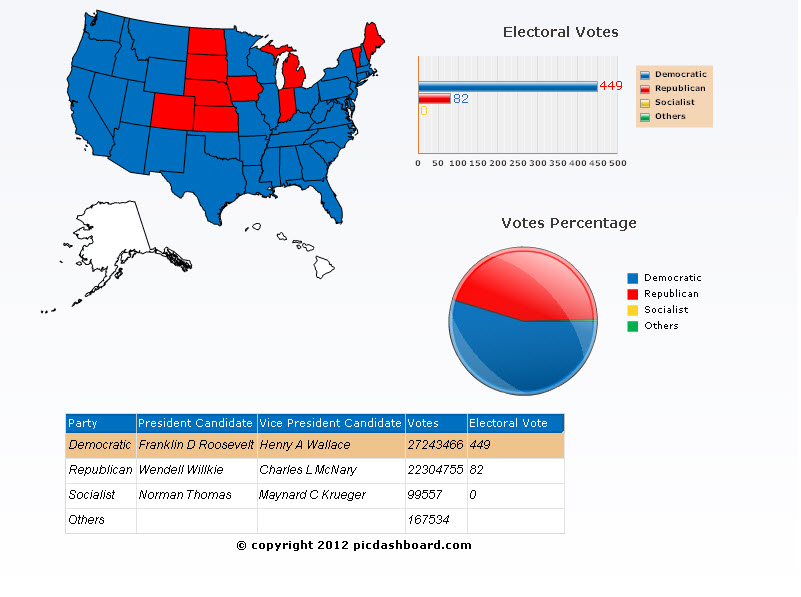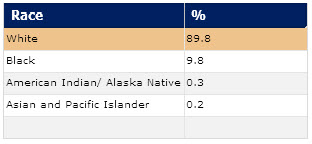United States Presidential Election 1940
In the US presidential elections of 1940, Democratic presidential candidate Franklin D Roosevelt defeated Republican presidential candidate Alf Landon with a margin of about 10%.
FDR broke the US tradition not to seek election after two terms and clings to his seat.
1940 Presidential Election Results
| Wendell Willkie | Republican Party |
| Democratic Party |

|
Political Situation:
1. First Election after the start of the disastrous World War II.
2. US economy still facing great depression, but starts a huge turn around due to demand for war related materials from Europe.
3. Hitler's forces unstoppable, France falls.
4. US doesn't enter World War II
Close States (margin<6%):
Colorado, Illinois, Indiana, Maine, Michigan, Wisconsin
Population by Race for the United States : Year 1940

|
|
Republican Party Agenda:
1. No US intervention in Europe's affairs.
2. Help farmer's by better managing excessive agriculture production.
3. USA should concentrate on defending its own shores.
4. Republican Party is opposed to FDR running to the president's position for a third term breaking the US tradition and also opposes projection of FDR as the only person capable to lead the nation.
Biography of Wendell L Willkie ( Republican party presidential candidate )
Wendell Willkie was born in Elwood, Indiana, February, 1892. He is a typical product of this country who worked with his hands throughout the West, taught school, evolved into a corporation lawyer and later a utility executive. While still in college he assisted his father, a lawyer, defend and win a case of some labor pickets against whom an injunction had been issued. In the army he defended soldiers up for court-martial on what he (Willkie was promoted from the ranks to captain), considered imbecile charges.As president of Commonwealth & Southern Corporation, operating utility properties over a wide area, Willkie supervised an annual pay roll in excess of $30,000,000. When the TVA project in the Tennessee Valley was built by the government, with facilities overlapping those of the Tennessee Power Company, a Commonwealth and Southern property, Willkie negotiated with the government and sold the property which his company controlled to the TVA.
Biography of Franklin D. Roosevelt ( Democratic party presidential candidate )
Franklin D Roosevelt was born January 30, 1882, in a fine old home overlooking the Hudson river, surrounded by trees and looking across a field where they had been cut for over a hundred years. His
godfather was Elliott Roosevelt, only brother of Theodore, who at that time
was beginning his political career.In 1900 he entered Harvard, to study law. Soon
after his graduation he married his distant cousin, Miss Anna Eleanor Roosevelt.
President Theodore Roosevelt considered her his favorite niece and,indeed, gave the bride away.
Franklin D. Roosevelt broke traditions even in his first campaign.
He talked to the voters from an automobile-then a detested "contraption" hated
by the farmers-and yet he was elected over his complacent opponent by a
strong rural vote. When Woodrow Wilson was elected President he offered the assistant
secretaryship of the navy to young Roosevelt. Six weeks after his 31st
birthday he took the oath of office, and from 1913 on he had under his immediate
direction the civilian personnel, the navy yards and docks, and the
purchasing of supplies.
In 1920 Roosevelt was nominated as the running mate with James M Cox. Public attention was soon after this to be focused sharply upon him. During a brief holiday he was stricken with infantile paralysis. Specialists
were hastily summoned in August, 1921, to a little island off the Maine coast.
It was generally believed that Roosevelt was apparently removed while still
a young man from the field of public endeavor.And yet we find him a year later back in his office, apparently "as
good as new.
As Governor OF New York
The first election was in itself a triumph. He was the first Democrat to carry upstate rural counties, being elected by a 25,000 majority in a year when the Republican party swept the country. The re-election of Roosevelt in 1930 was most dramatic. He took the campaign straight to the people and into the Republican strongholds. The result was the now-famous "landslide" victory
